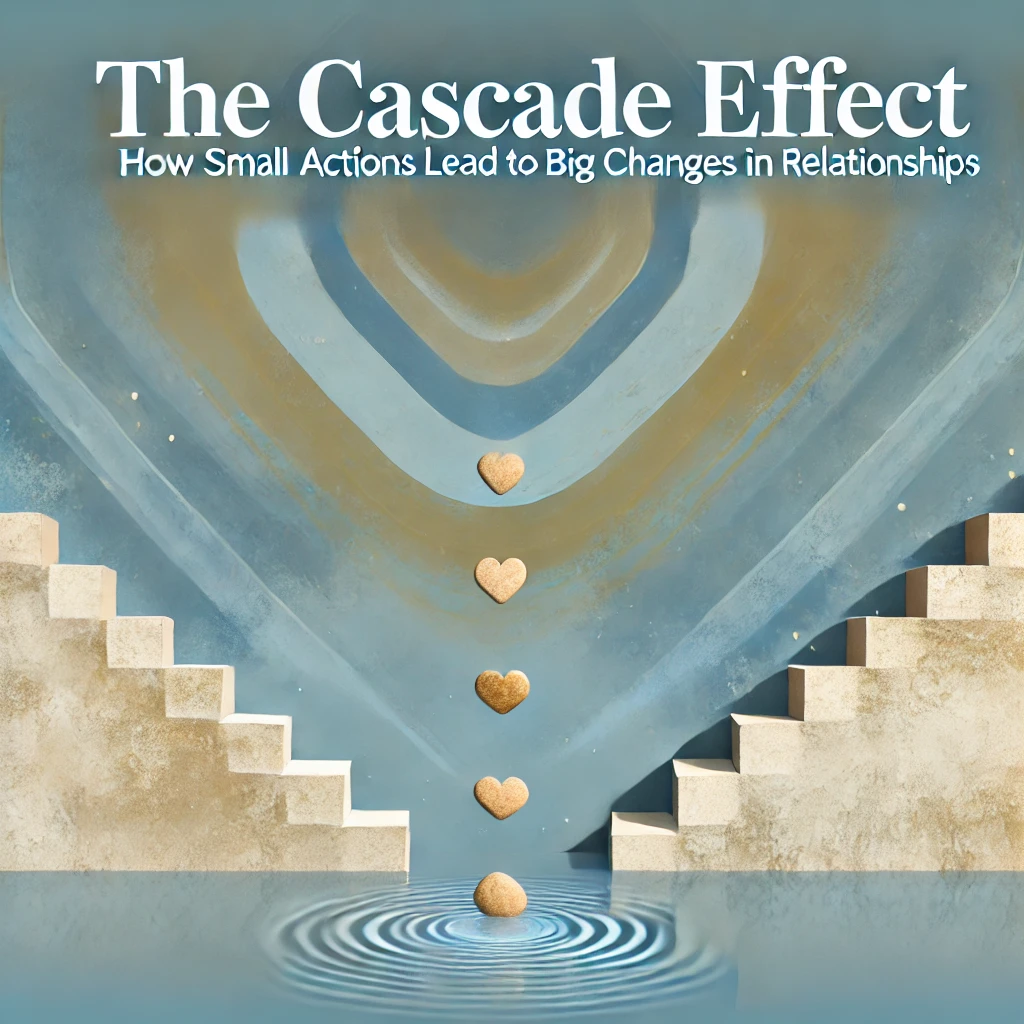In every relationship, it’s often the small, seemingly insignificant moments that accumulate over time and lead to major shifts in how we interact, communicate, and feel about one another. This phenomenon is known as The Cascade Effect—a process where a single action or decision triggers a series of reactions, ultimately leading to a significant transformation in the relationship. Understanding and harnessing the Cascade Effect allows you to influence the direction of your relationship subtly but powerfully, making small adjustments that snowball into bigger, positive changes.
The Cascade Effect teaches us that we don’t need to make grand gestures or drastic decisions to change the dynamic of a relationship. Instead, we can focus on small, consistent actions that, over time, create a ripple effect, influencing behavior, emotional connection, and even long-term relationship satisfaction. From the way you greet your partner in the morning to how you handle disagreements, these little moments contribute to the overall health and strength of your bond.
In this blog, we’ll dive deep into The Cascade Effect, explore why it works so effectively in relationships, and show how small actions can lead to big transformations. We’ll also provide relatable examples to help you apply this strategy in your relationship, ensuring that you can start making small changes that will ultimately strengthen your connection and lead to long-term happiness.
What Is The Cascade Effect in Relationships?
The Cascade Effect in relationships refers to the idea that small, consistent behaviors or actions can lead to larger, more significant changes over time. It’s similar to the “snowball effect”—a single snowflake doesn’t seem like much, but as it rolls down a hill and picks up more snowflakes, it grows into a large snowball. In relationships, small gestures like kindness, patience, or listening can build upon each other, creating a strong foundation of trust, respect, and love.
On the flip side, negative actions or small moments of neglect can also cascade into larger problems. A minor issue, if left unresolved, can build resentment or dissatisfaction. This is why being intentional with even the smallest actions is so important—those actions set the tone for the relationship as a whole.
Why Does the Cascade Effect Work in Relationships?
The Cascade Effect works because relationships are built on accumulation. No one argument, compliment, or gesture defines the entire relationship, but over time, these moments build up and create a larger narrative. When we consistently behave in a way that fosters connection, understanding, and respect, it reinforces those qualities in the relationship.
It’s not about perfection—it’s about persistence. Small actions compound, creating either positive or negative effects over time. By focusing on small, manageable changes, you can steer your relationship in the direction you want, avoiding overwhelm while still making meaningful progress.
How to Use The Cascade Effect to Strengthen Your Relationship
Let’s explore some practical, real-life examples of how small, consistent actions can trigger the Cascade Effect and lead to significant positive changes in your relationship.
Example 1: Small Acts of Kindness Every Day
One of the easiest ways to trigger the Cascade Effect in your relationship is by consistently practicing small acts of kindness. These don’t have to be grand gestures—they can be as simple as making your partner’s morning coffee, sending a sweet text, or offering a genuine compliment.
How to Trigger the Cascade Effect:
Make it a habit to do one small, kind thing for your partner every day. It could be leaving a sticky note with a loving message on the bathroom mirror or taking care of a chore they dislike without being asked.
Why It Works:
These small acts build emotional capital in the relationship. Over time, your partner will feel more appreciated and loved, which fosters an atmosphere of mutual respect and affection. These positive feelings will eventually lead to more closeness and connection.
Example 2: Consistently Practicing Active Listening
Active listening—truly paying attention to your partner’s thoughts, feelings, and concerns—may seem like a small gesture, but it can have a profound impact when practiced regularly. By simply being present in conversations, you make your partner feel heard and valued.
How to Trigger the Cascade Effect:
Whenever your partner speaks, give them your full attention. Put your phone away, make eye contact, and ask follow-up questions that show you’re engaged in the conversation. Do this consistently, especially during important or emotionally charged discussions.
Why It Works:
Over time, your partner will feel more understood and supported. This increases trust and emotional intimacy, leading to fewer misunderstandings and deeper connection. A relationship built on mutual understanding creates a positive feedback loop of communication and support.
Example 3: Showing Patience in Small Conflicts
Arguments and disagreements are inevitable in any relationship, but how you handle them can set the tone for future interactions. Instead of reacting impulsively in small conflicts, practice patience and empathy.
How to Trigger the Cascade Effect:
The next time you disagree, take a deep breath before responding. Ask yourself, “How can I respond in a way that promotes understanding rather than escalation?” Focus on de-escalating the situation rather than winning the argument.
Why It Works:
When you consistently approach disagreements with patience, your partner will notice. Over time, this encourages both of you to communicate more calmly and respectfully, reducing the frequency and intensity of arguments. The cascade of respectful communication leads to a more peaceful and harmonious relationship.
Example 4: Expressing Gratitude Regularly
Expressing gratitude is one of the most powerful ways to trigger the Cascade Effect in a relationship. A simple “thank you” or an acknowledgment of something your partner did can go a long way in fostering positivity.
How to Trigger the Cascade Effect:
Make it a point to regularly express gratitude for both the big and small things your partner does. Whether it’s thanking them for making dinner or appreciating how they support you emotionally, verbalize your gratitude consistently.
Why It Works:
Over time, consistent expressions of gratitude build a culture of appreciation in the relationship. Your partner will feel valued, and this positive reinforcement encourages more acts of kindness and support. This cascade of gratitude leads to a more affectionate and generous relationship.
Example 5: Physical Affection in Small Doses
Physical affection, like hugs, kisses, or simply holding hands, is a small but powerful way to foster connection and intimacy in a relationship. Regular physical touch helps reinforce emotional bonds and makes both partners feel more secure.
How to Trigger the Cascade Effect:
Make physical affection a regular part of your daily interactions. It could be as simple as giving your partner a hug when they get home from work or holding hands while watching TV.
Why It Works:
Consistent physical affection builds a sense of closeness and security. Over time, it strengthens the emotional and physical bond between you and your partner, creating a cascade of intimacy and affection that deepens the relationship.
The Cascade Effect in Reverse: How Small Negative Actions Can Add Up
Just as small positive actions can create a positive cascade, small negative behaviors can have the opposite effect. Ignoring your partner’s needs, snapping at them in moments of frustration, or neglecting to show appreciation can lead to feelings of resentment, distance, and dissatisfaction.
This is why it’s so important to be mindful of the small, everyday actions you take in your relationship. Negative patterns, even if they seem insignificant at first, can snowball into bigger issues if left unchecked. By staying aware of your actions and making an effort to choose positive behaviors, you can prevent a negative cascade from taking hold.
Why The Cascade Effect Is So Powerful in Relationships
The Cascade Effect is powerful because it’s rooted in consistency. While big gestures and dramatic changes may have an immediate impact, it’s the small, everyday actions that truly define the tone of a relationship. The little things add up, creating a larger pattern of behavior that either strengthens or weakens the connection between you and your partner.
When you focus on making small, positive changes, you give your relationship the space to grow and evolve in a healthy, sustainable way. These small actions accumulate over time, leading to a deeper emotional bond, better communication, and a stronger sense of mutual respect and support.
Tips for Triggering The Cascade Effect in Your Relationship
Here are a few tips for effectively triggering the Cascade Effect in your relationship:
- Focus on Consistency: It’s not about doing something grand once in a while—it’s about showing up in small, meaningful ways every day.
- Start with One Area: Whether it’s communication, affection, or kindness, choose one area to focus on initially. Small changes in one area will naturally cascade into other areas of the relationship.
- Be Patient: The Cascade Effect takes time. Don’t expect immediate results—just trust that small, consistent actions will build momentum over time.
- Avoid Negative Cascades: Be mindful of small negative actions that could lead to a downward spiral. If you notice a negative pattern, address it early before it escalates.
Q&A:
- What is the Cascade Effect in relationships?
The Cascade Effect in relationships is the idea that small, consistent actions can lead to major, lasting changes over time, creating a ripple effect in how partners interact and connect. - How do small actions impact long-term relationship health?
Small actions build up emotional capital, fostering connection, respect, and trust, while small negative behaviors can accumulate into larger issues like resentment or disconnect. - How can I use the Cascade Effect to strengthen my relationship?
Simple actions like active listening, expressing gratitude, and regular kindness contribute to a positive cascade that strengthens the bond between partners over time. - What are examples of the Cascade Effect in relationships?
Examples include daily acts of kindness, practicing patience during conflicts, and showing consistent appreciation—each of which gradually enhances emotional closeness and communication. - Can small negative actions harm a relationship?
Yes, small negative actions like criticism, neglect, or impatience can lead to a negative cascade, eroding trust and connection if left unchecked. - Why do small, consistent actions matter more than big gestures?
Consistency creates a foundation of trust and predictability, while big gestures, though impactful, don’t have the same sustained influence on relationship quality. - How does expressing gratitude daily affect relationships?
Regular expressions of gratitude foster appreciation and mutual respect, creating a cascade of positive reinforcement that encourages more supportive behaviors. - What role does patience play in the Cascade Effect?
Patience during conflicts prevents escalation, leading to calmer interactions and encouraging a mutual approach to problem-solving over time. - How can I avoid creating a negative Cascade Effect?
Be mindful of small negative actions and address issues early. Making an effort to choose positive behaviors daily helps steer the relationship in a healthy direction. - What’s the difference between the Cascade Effect and the snowball effect in relationships?
The Cascade Effect involves intentional, consistent actions that build up positively over time, while the snowball effect is a general term for how actions, good or bad, accumulate.
Ready to Harness the Power of The Cascade Effect in Your Relationship?
If you’re ready to take control of your relationship and make meaningful changes, “Mastering Him: The Secret Art of Gentle Control in Relationships” is the guide for you. In Chapter 8, you’ll learn more about The Cascade Effect and discover 12 other powerful techniques to subtly influence your partner’s behavior, decisions, and emotions.
Get your copy today and start mastering the art of influence in your relationship. It’s time to turn small actions into big transformations—without conflict or pressure!
Read more about the book: https://developmentpill.com/mastering-him-the-secret-art-of-gentle-control-in-relationships-a-guide-to-influence-hell-never-see-coming/
Book Link: https://www.amazon.com/dp/B0DKKGLZQ9
Book Link UK: https://www.amazon.co.uk/dp/B0DKKGLZQ9
You can find book Links for other regions in this post page: https://developmentpill.com/mastering-him-the-secret-art-of-gentle-control-in-relationships-a-guide-to-influence-hell-never-see-coming/



